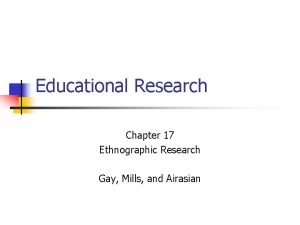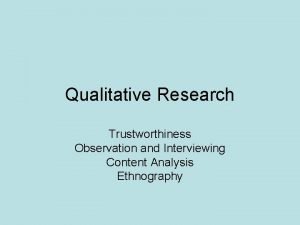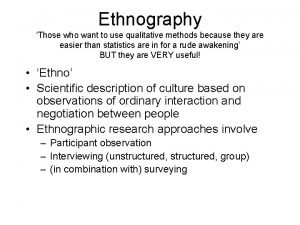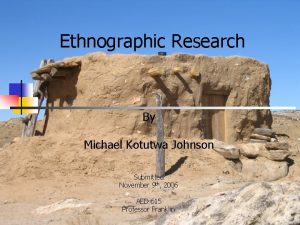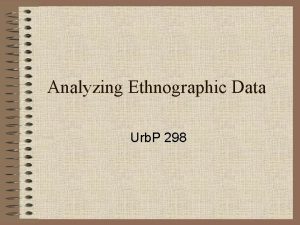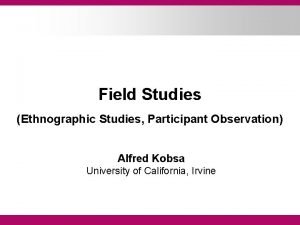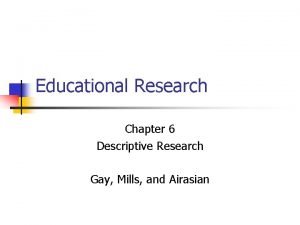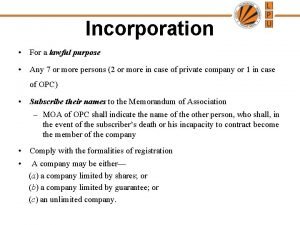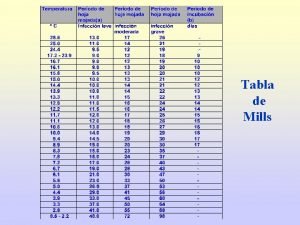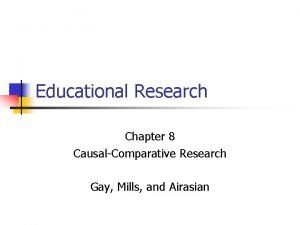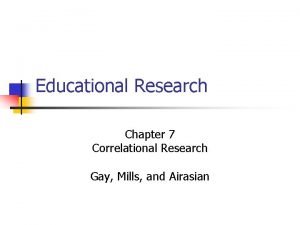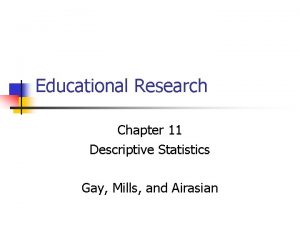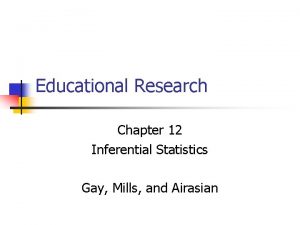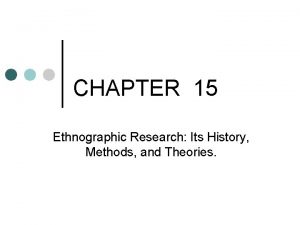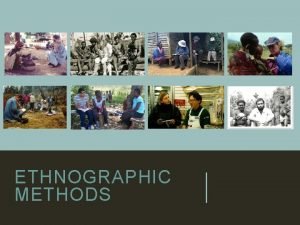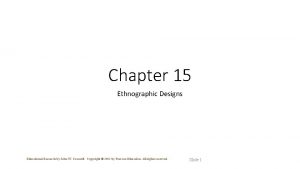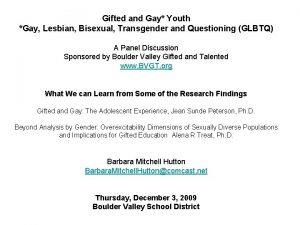Educational Research Chapter 17 Ethnographic Research Gay Mills























- Slides: 23

Educational Research Chapter 17 Ethnographic Research Gay, Mills, and Airasian

Topics Discussed in this Chapter n n n The definition and purpose of ethnographic research The ethnographic research process The types of ethnographic research Key characteristics of ethnographic research designs Ethnographic research data collection techniques

Definition and Purpose n Ethnographic research n Definition n n A qualitative approach that studies the cultural patterns and perspectives of participants in their natural settings Purpose n To describe, analyze, and interpret the culture of a group over time to understand the group’s shared beliefs, behaviors, and language Objectives 1. 1 & 1. 2

Definition and Purpose n Ethnographic research n Culture is the set of shared attitudes, values, concepts, beliefs, and practices that can be attributed to the members of the group being studied n Three broad areas to help focus on tangible cultural behaviors n n n Cultural orientation – where the people are situated Cultural know-how – how a group goes about daily activities Cultural beliefs – why a group does what it does Objective 1. 3

The Ethnographic Process n Nine steps to conduct an ethnographic study n Identify the purpose of the research study n n Frame the study as a larger theoretical, policy, or practical problem n n The importance of most ethnographic problems is readily apparent Pose initial ethnographic research questions n n A clear idea with some connection to cultural issues Use general guiding questions that foreshadow the issue Describe the overall approach and rationale for the study Objective 2. 1

The Ethnographic Process n Nine steps (continued) n Describe the site and sample selection n The use of purposive sampling techniques The use of key informants Describe the researcher’s role n n n Entry to the site Reciprocity Ethics Objective 2. 1

The Ethnographic Process n Nine steps (continued) n Describe the data collection methods n n n Describe appropriate strategies for the analysis and interpretation of data n n Participant observation Field notes Interviews Artifacts Use the methods discussed in the chapter on data collection and analysis Write the ethnographic account Objective 2. 1

Types of Ethnographic Research n Two differentiating features n n n The product itself, that is, the ethnography The researcher’s intent Three common types n The realist ethnography n n n The author studies the culture of schools Written in an objective style Uses common categories for cultural description, analysis, and interpretation Objectives 3. 1 & 3. 2

Types of Ethnographic Research n Three common types (continued) n The ethnographic case study n n n The focus is on describing a specific case Descriptions of the activities undertaken by the group and the shared patterns of behavior that develop over time The critical ethnography n n The author is interested in advocating for the emancipation of groups marginalized in our society Highly politicized Advocates against inequities and domination of particular groups in society Addresses issues of power, authority, emancipation, oppression, and inequity Objectives 3. 1 & 3. 2

Characteristics of Ethnographic Research n 15 distinctive characteristics n n n Conducted in a natural context Involves intimate face-to-face interactions with participants Reflects participants’ perspectives and behaviors Uses inductive, interactive, and recursive collection of unstructured data Data is collected primarily through fieldwork experiences Objective 4. 1

Characteristics of Ethnographic Research n 15 distinctive characteristics (continued) n n Uses multiple data sources including both quantitative and qualitative Frames all human behavior and beliefs within a socio-political and historical context Uses the concept of culture as a lens through which the results are interpreted Places an emphasis on exploring the nature of particular social phenomena Objective 4. 1

Characteristics of Ethnographic Research n 15 distinctive characteristics (continued) n n n Investigates a small number of cases in detail Uses data analyses that involve the explicit interpretation of the meanings and functions of human actions that are presented through the description of themes and interpretations within the context or group setting Offers interpretations of people’s actions and behaviors that are uncovered through the investigation of what they actually do and the reasons for doing it Objective 4. 1

Characteristics of Ethnographic Research n 15 distinctive characteristics (continued) n n Offers a representation or interpretation of people’s lives and behaviors that is neither the researcher’s or the participants’ but is built on the points of understanding and misunderstanding that occur between the researcher and participants Are necessarily partial, bound by what can be handled within a certain time, under certain specific circumstances, and from a particular perspective Objective 4. 1

Ethnographic Techniques n Three major techniques n n Triangulation Participant observation Field notes Triangulation n n Collecting data using many sources rather than a single one Multiple sources n n n Interviews Observations Artifacts Objective 5. 1

Ethnographic Techniques n Triangulation (continued) n n n Multiple informants Consistency across sources and informants creates a stronger understanding of what is truly going on Participant observation n The researcher is immersed in the research setting in order to get close to those studied as a way of understanding what their experiences and activities mean to them Objectives 5. 1 & 5. 2

Ethnographic Techniques n Participant observation (continued) n Two purposes n n n To observe the activities, people, and physical aspects of a situation To engage in activities that provide useful information in a given situation Three varying degrees of participation n Active participant observer – active engagement Privileged active observer – engaged in a more active, privileged manner such as teaching a lesson Passive observer – little, if any, engagement Objectives 5. 3 & 5. 4

Ethnographic Techniques n Participant observation (continued) n Recommended social behaviors n n Negotiating entrance into the setting requires the researcher to be able to clearly describe the purpose, plan, and constraints likely associated with the research Reciprocity requires the researcher to move between formal and informal ways of interacting with participants Objective 5. 5

Ethnographic Techniques n Recommended social behaviors (continued) n n The researcher must have a tolerance for ambiguity The researcher must have personal determination coupled with a faith in oneself Objective 5. 5

Ethnographic Techniques n Field notes n n A record of the researcher’s understanding of the lives, people, and events that are the focus of the research The link between field notes and the research n n What is observed is ultimately treated as data When writing field notes researchers should give particular attention to the indigenous meanings and concerns of the people studied Objective 5. 6

Ethnographic Techniques n The link between field notes and the research (continued) n n Field notes provide essential grounding for writing broader, more coherent accounts of others’ lives and concerns Field notes detail the social and interactional processes that make up people’s everyday lives and activities Objective 5. 6

Ethnographic Techniques n Recommendations for observing and recording field notes n n Make mental notes and record them as soon as possible after observing Jot down key information n n Capture key words and phrases without a lot of explanation Use a mnemonic device to help reconstruct the observed events Objective 5. 7

Ethnographic Techniques n Recommendations (continued) n n Don’t worry about grammar or other rules Trace what you did during the day Avoid the temptation to recreate dialogue Describe as completely and accurately as you can all relevant aspects of the observation Objective 5. 7

Ethnographic Techniques n Recommendations (continued) n n Record your personal reactions (i. e. , reflective field notes) Observe and record everything you possibly can Observe and look for nothing in particular Look for “bumps” or paradoxes Objective 5. 7
 Tony mills gay
Tony mills gay Educational research gay
Educational research gay Ethnographic research
Ethnographic research Ethnography template
Ethnography template How to do an ethnography
How to do an ethnography Example of problem statement in research proposal
Example of problem statement in research proposal Ethnographic research
Ethnographic research Ethnographic research
Ethnographic research Ethnographic interview questions
Ethnographic interview questions Analyzing ethnographic data
Analyzing ethnographic data Ethnographic analogy
Ethnographic analogy Rapid ethnographic assessment
Rapid ethnographic assessment Ethnographic field studies
Ethnographic field studies Gay 2012 descriptive research
Gay 2012 descriptive research Robert merton contribution to sociology
Robert merton contribution to sociology Alexa mills
Alexa mills Jubilee cotton mills v lewis
Jubilee cotton mills v lewis Icat catalogue
Icat catalogue Introduction of milling machine
Introduction of milling machine Arco labial de mill
Arco labial de mill Fungsi administrasi menurut mills meliputi…
Fungsi administrasi menurut mills meliputi… Uses of adams clasp
Uses of adams clasp Sarna
Sarna Artesanato intelectual mills
Artesanato intelectual mills


